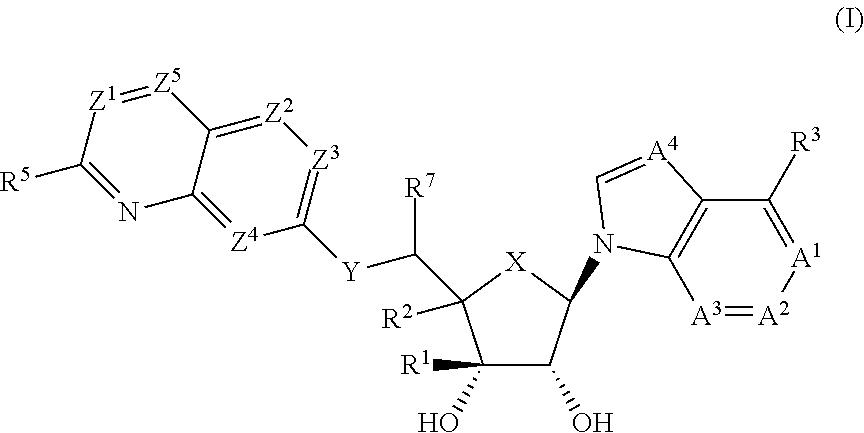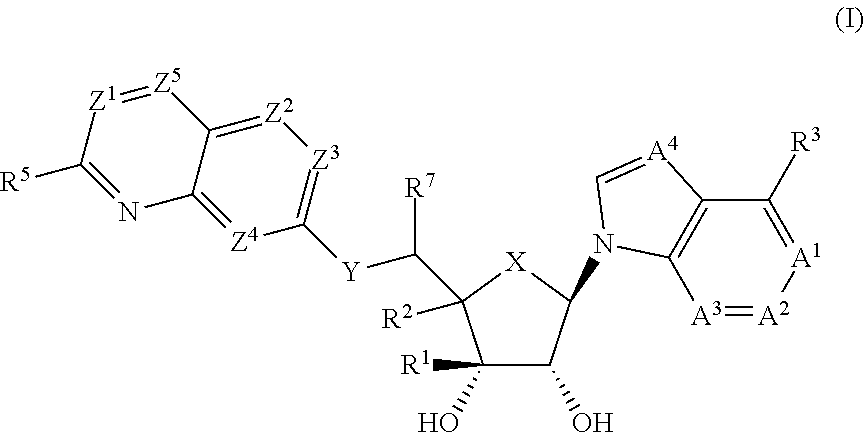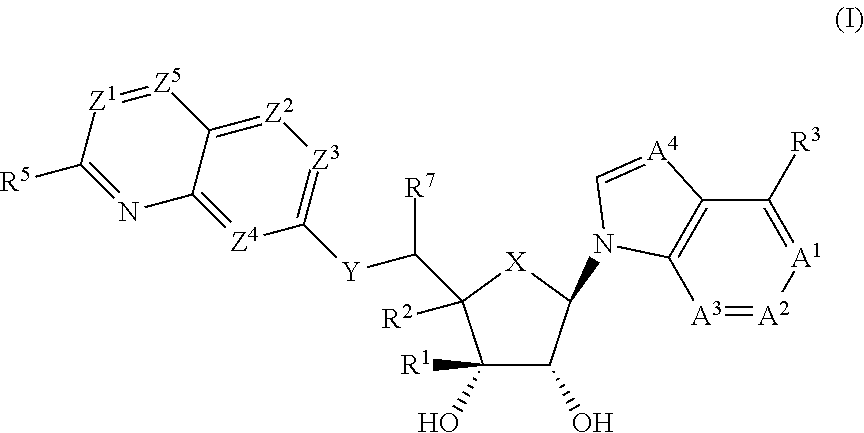Prmt5 inhibitors
a technology of inhibitors and receptors, applied in the field of receptor-mediated tyrosine inhibitors, can solve problems such as elusive mechanisms
- Summary
- Abstract
- Description
- Claims
- Application Information
AI Technical Summary
Benefits of technology
Problems solved by technology
Method used
Image
Examples
example 1
(1R,2S,3R,5R)-5-((2-amino-3-bromoquinolin-7-yl)oxy)methyl)-3-(4-chloro-7H-pyrrolo[2,3-d]pyrimidin-7-yl)-1-methylcyclopentane-1,2-diol
[0672]
[0673]Step 1: A mixture of ((3aR,4R,6R,6aS)-6-(4-chloro-7H-pyrrolo[2,3-d]pyrimidin-7-yl)-2,2,3a-trimethyltetrahydro-3aH-cyclopenta[d][1,3]dioxol-4-yl)methanol (1.2 g, 3.6 mmol), 2-amino-3-bromoquinolin-7-ol (0.934 g, 3.91 mmol) and triphenylphosphine (1.86 g, 7.10 mmol) was co-evaporated with dry toluene (three times, 10 mL each) and then re-dissolved in anhydrous THF (20 mL). The reaction mixture was cooled to 0° C., and (E)-diisopropyl diazene-1,2-dicarboxylate (144 g, 7.10 mmol) was added dropwise at 0° C. The mixture was warmed to room temperature naturally, and the mixture was stirred at room temperature for 2 hours. The reaction mixture was concentrated under reduced pressure. The residue was purified by silica gel column chromatography (0-10% MeOH in DCM). The fractions containing the desired product were combined and concentrated under re...
example 2
(1R,2S,3R,5R)-5-((2-amino-3-bromoquinolin-7-yl)oxy)methyl)-3-(4-amino-7H-pyrrolo[2,3-d]pyrimidin-7-yl)-1-methylcyclopentane-1,2-diol
[0675]
[0676]To a sealed tube (10 mL) was added (1R,2S,3R,5R)-5-(((2-amino-3-bromoquinolin-7-yl)oxy)methyl)-3-(4-chloro-7H-pyrrolo[2,3-d]pyrimidin-7-yl)-1-methylcyclopentane-1,2-diol (350 mg, 0.675 mmol), 1,4-dioxane (3 mL) and NH3.H2O (5 mL; 25%-28% w / w) at room temperature. The reaction mixture was sealed tightly and then stirred at 90° C. for 16 hours. The reaction mixture was concentrated under reduced pressure. The residue was purified by reverse phase HPLC (0-45% acetonitrile / water) to afford (1R,2S,3R,5R)-5-(((2-amino-3-bromoquinolin-7-yl)oxy)methyl)-3-(4-amino-7H-pyrrolo[2,3-d]pyrimidin-7-yl)-1-methylcyclopentane-1,2-diol. MS 499, 501 (M+1, M+3). 1H NMR (400 MHz, DMSO-d6) δ 8.28 (s, 1H), 8.02 (s, 1H), 7.58 (d, J=8.7 Hz, 1H), 7.30 (d, J=3.6 Hz, 1H), 6.96-6.89 (m, 4H), 6.57-6.53 (m, 3H), 4.97-4.91 (m, 2H), 4.41 (s, 1H), 4.19-4.10 (m, 3H), 2.45-2.37...
example 3
(2R,3S,4R,5R)-2-(((2-amino-3-bromoquinolin-7-yl)oxy)methyl)-5-(4-amino-7H-pyrrolo[2,3-d]pyrimidin-7-yl)-3-ethynyltetrahydrofuran-3,4-diol
[0677]
[0678]Step 1: (2R,3R,4S,5R)-2-(4-amino-7H-pyrrolo[2,3-d]pyrimidin-7-yl)-5-(hydroxymethyl)tetrahydrofuran-3,4-diol (2 g 7.5 mmol) was co-evaporated with dry pyridine (10 mL×3) and then re-suspended in dry pyridine (30 mL) at ambient temperature under an argon atmosphere. To this suspension was added chlorotrimethylsilane (5.71 g, 52.6 mmol) in one portion at 0° C., and the mixture was maintained at ambient temperature for 1 hour. Then to the mixture was added benzoyl chloride (1.58 g, 11.3 mmol) at 0° C. After stirring at ambient temperature for 2 h, the resulting mixture was quenched with H2O (8 mL) at 0° C. Then aqueous NH3 solution (15 mL, 25-28% wt) was added drop wise at 0° C. followed by stirring at ambient temperature for 30 min. The reaction mixture was concentrated under reduced pressure, and the residue was purified by column chromat...
PUM
 Login to View More
Login to View More Abstract
Description
Claims
Application Information
 Login to View More
Login to View More - R&D
- Intellectual Property
- Life Sciences
- Materials
- Tech Scout
- Unparalleled Data Quality
- Higher Quality Content
- 60% Fewer Hallucinations
Browse by: Latest US Patents, China's latest patents, Technical Efficacy Thesaurus, Application Domain, Technology Topic, Popular Technical Reports.
© 2025 PatSnap. All rights reserved.Legal|Privacy policy|Modern Slavery Act Transparency Statement|Sitemap|About US| Contact US: help@patsnap.com



